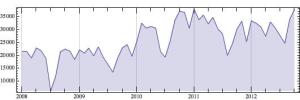
The Matsuoka family on their just-cleared berry farm in Haney, British Columbia, prior to the Second World War. The author’s mother, Ritsuko is in the back row, far right. Source: author’s personal collection.
By Pam Sugiman
This is the third in a series of posts originally presented as part of a roundtable entitled “What’s the Use of History? Citizenship and History in Canada’s Past and Present,” held in Toronto on October 16th 2012. The event was organized by the People’s Citizenship Guide Project.
Personal memory and history
As a contributor to this series on citizenship and history in Canada, I wish to offer some reflections on citizenship and its meaning — through the eyes of a Japanese-Canadian woman of working class origins. I am a Sansei (third-generation Japanese Canadian), born and raised in the west end of Toronto. I grew up in the 1960s. My Nisei (second-generation) parents were born in British Columbia (BC), where they lived until the events of the Second World War. Following the war, and to a large extent because of the wartime events, my father spent most of his adult life as a taxi driver for the Diamond Cab Company. From the time that she arrived at Toronto’s Union Station, after a long train trip from Rosebery, BC, my mother made a living cleaning homes and taking care of children of upper-middle-class families in the affluent neighbourhoods of Rosedale and Forest Hill. Both of my Issei (first-generation) grandfathers immigrated to Canada from Japan in the late 1800s, first stopping to earn wages by doing agricultural labour in Hawaii. My mother’s mother and father’s mother both came to this country as Japanese picture brides. Prior to the war, they spent their lives in Canada raising children, cooking, maintaining the household, working on the family farm, and doing seasonal cannery work.

The author’s father, Ross Tatsuro Sugiman in London, Ontario where he was sent to perform low-wage labour, after being released from a POW camp. Source: author’s personal collection.
My reflections on citizenship and the nation are very much a product of my family’s historical experiences. And over time, these family experiences, now embedded in personal memory, have intermingled with the memories of the dozens of other Nisei women and men that I have interviewed over the past decade and a half, as an historical sociologist. Continue reading →







